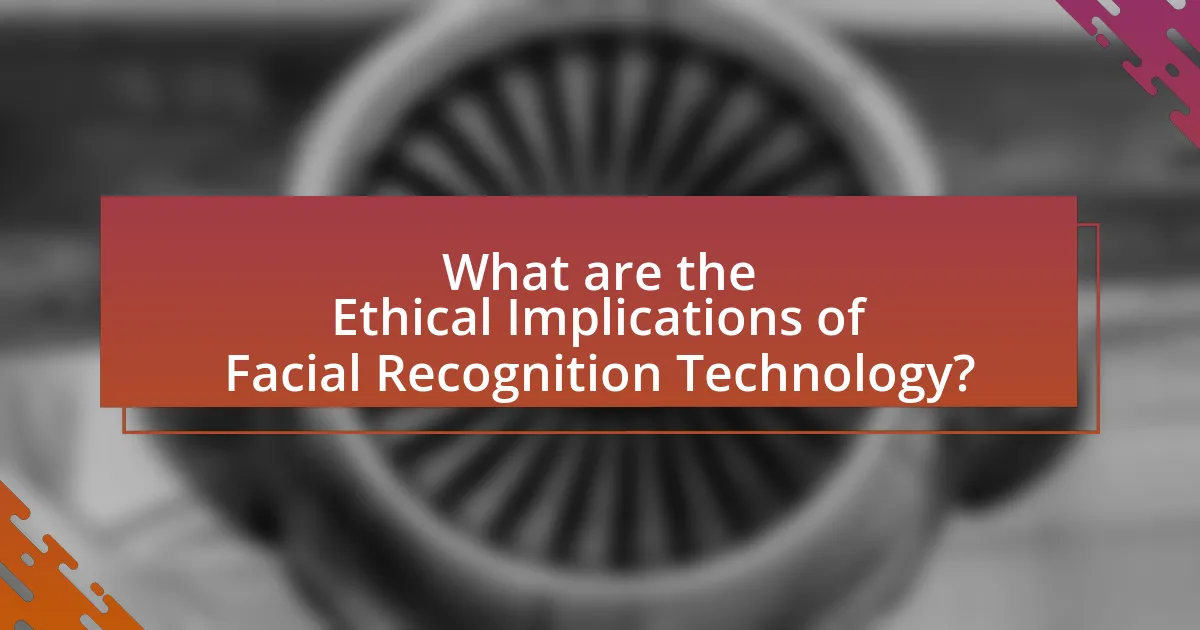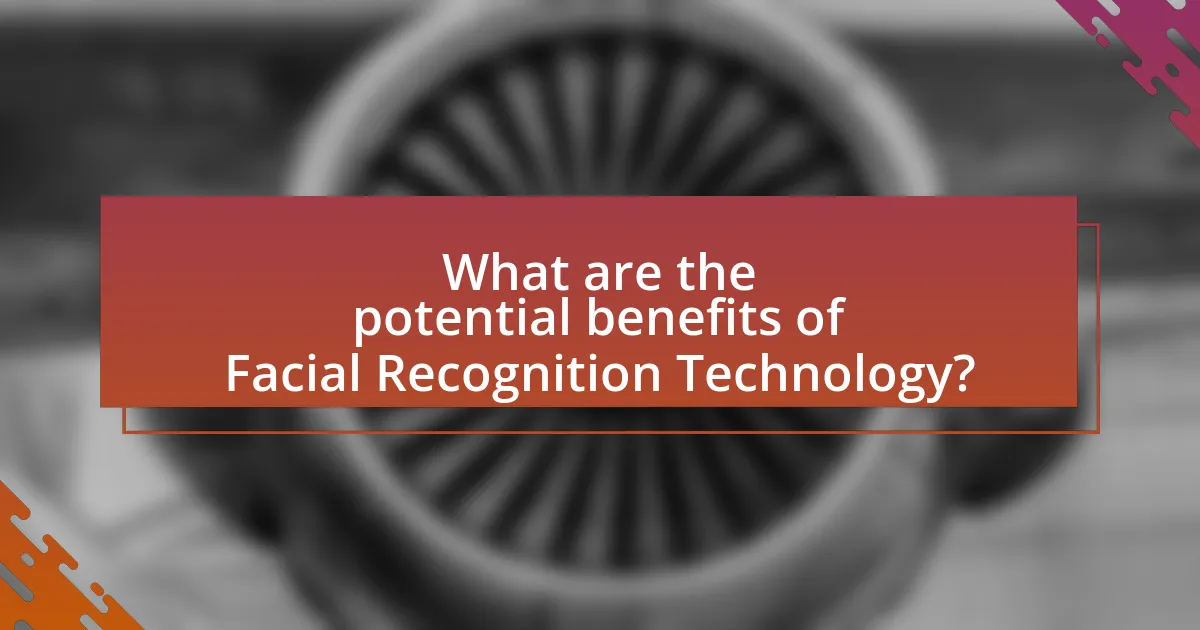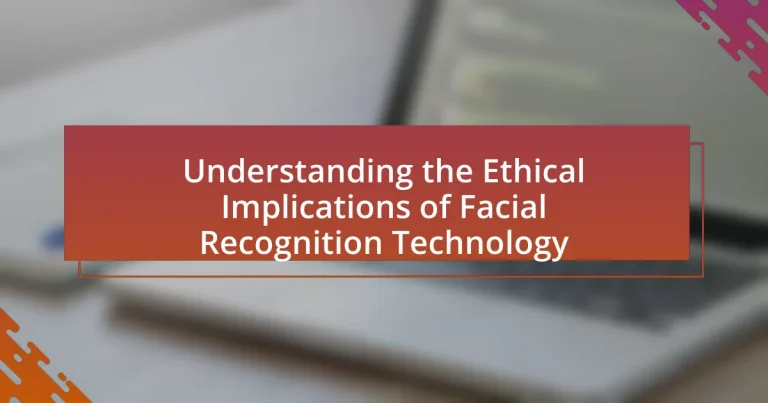Facial recognition technology (FRT) presents significant ethical implications, primarily concerning privacy, bias, and consent. The technology enables mass surveillance, raising privacy concerns as it can infringe on individual rights and lead to unauthorized data collection. Studies indicate that FRT often misidentifies marginalized groups, exacerbating societal biases and discrimination. The article explores the impact of FRT on privacy rights, the risks associated with its use, and the varying regulatory frameworks across jurisdictions. Additionally, it addresses the societal effects of FRT, particularly on marginalized communities, and discusses best practices for ethical implementation, emphasizing the need for transparency, informed consent, and collaboration among stakeholders to mitigate ethical concerns.

What are the Ethical Implications of Facial Recognition Technology?
The ethical implications of facial recognition technology include privacy concerns, potential for bias, and issues of consent. Privacy concerns arise as the technology can enable mass surveillance, infringing on individuals’ rights to anonymity and freedom of expression. Studies indicate that facial recognition systems often misidentify individuals, particularly among marginalized groups, leading to discriminatory practices and reinforcing societal biases. Furthermore, the lack of informed consent in data collection processes raises ethical questions about individuals’ autonomy and control over their personal information. These implications necessitate careful consideration and regulation to ensure ethical deployment of facial recognition technology.
How does Facial Recognition Technology impact privacy rights?
Facial recognition technology significantly impacts privacy rights by enabling the mass surveillance of individuals without their consent. This technology allows governments and private entities to identify and track people in public spaces, raising concerns about unauthorized data collection and the potential for misuse. For instance, a report by the Electronic Frontier Foundation highlights that facial recognition systems can lead to wrongful arrests and discrimination, particularly against marginalized communities. Furthermore, studies indicate that 79% of Americans express concern about the use of facial recognition by law enforcement, reflecting widespread apprehension regarding privacy violations.
What are the potential risks to individual privacy?
The potential risks to individual privacy include unauthorized surveillance, data breaches, and misuse of personal information. Unauthorized surveillance occurs when facial recognition technology is used without consent, allowing entities to track individuals’ movements and activities. Data breaches can expose sensitive biometric data, leading to identity theft and other privacy violations. Misuse of personal information happens when collected data is used for purposes beyond the original intent, such as profiling or discrimination. According to a report by the Electronic Frontier Foundation, these risks highlight the need for stringent regulations to protect individual privacy in the context of facial recognition technology.
How do different jurisdictions regulate privacy in facial recognition?
Different jurisdictions regulate privacy in facial recognition through a combination of laws, guidelines, and policies that vary significantly across regions. For instance, the European Union enforces the General Data Protection Regulation (GDPR), which mandates strict consent requirements and data protection measures for biometric data, including facial recognition. In contrast, the United States has a more fragmented approach, with some states like California implementing the California Consumer Privacy Act (CCPA) that provides consumers with rights regarding their personal data, while other states lack comprehensive regulations. Additionally, countries like Canada have established guidelines through the Office of the Privacy Commissioner, emphasizing transparency and accountability in the use of facial recognition technology. These regulatory frameworks reflect varying cultural attitudes towards privacy and surveillance, influencing how facial recognition is deployed and monitored in different jurisdictions.
What are the societal impacts of Facial Recognition Technology?
Facial Recognition Technology (FRT) significantly impacts society by enhancing security measures while raising ethical concerns regarding privacy and surveillance. The implementation of FRT in public spaces, such as airports and city streets, has led to increased identification of individuals, which can deter crime and assist law enforcement. However, studies indicate that this technology can also lead to racial profiling and discrimination, as algorithms may exhibit biases against certain demographic groups. For instance, a 2019 study by the National Institute of Standards and Technology found that facial recognition algorithms misidentified Black and Asian faces at rates significantly higher than those of white faces. This disparity raises critical questions about fairness and accountability in the deployment of FRT, highlighting the need for regulations that balance security benefits with the protection of individual rights.
How does facial recognition affect marginalized communities?
Facial recognition technology disproportionately affects marginalized communities by increasing surveillance and the likelihood of misidentification. Studies have shown that these systems often exhibit higher error rates for individuals with darker skin tones, leading to wrongful accusations and heightened police scrutiny. For instance, a 2019 study by the National Institute of Standards and Technology found that facial recognition algorithms misidentified Black individuals at rates up to 100 times higher than white individuals. This systemic bias can exacerbate existing inequalities, resulting in a loss of trust in law enforcement and further marginalization of these communities.
What role does facial recognition play in surveillance and law enforcement?
Facial recognition plays a critical role in surveillance and law enforcement by enabling the identification and tracking of individuals in real-time. This technology assists law enforcement agencies in solving crimes, locating missing persons, and enhancing public safety through the analysis of video footage from public spaces. For instance, a study by the National Institute of Standards and Technology (NIST) found that facial recognition systems can achieve accuracy rates exceeding 99% under optimal conditions, demonstrating their effectiveness in identifying suspects. Additionally, law enforcement agencies have increasingly adopted facial recognition technology, with reports indicating that over 20% of U.S. police departments utilize it as part of their investigative processes.
What ethical concerns arise from the use of Facial Recognition Technology?
The ethical concerns arising from the use of Facial Recognition Technology include privacy violations, potential for misuse, and bias in algorithmic decision-making. Privacy violations occur as individuals may be monitored without their consent, leading to unauthorized data collection. The potential for misuse is significant, as governments or organizations could exploit this technology for surveillance or discriminatory practices. Additionally, studies have shown that facial recognition systems often exhibit bias, particularly against marginalized groups, resulting in higher rates of misidentification and reinforcing existing societal inequalities. For instance, a 2019 study by the National Institute of Standards and Technology found that facial recognition algorithms had higher error rates for Asian and Black faces compared to White faces, highlighting the ethical implications of deploying such technology without addressing these biases.
How does bias in facial recognition algorithms affect outcomes?
Bias in facial recognition algorithms leads to inaccurate identification and misclassification, disproportionately affecting marginalized groups. Studies have shown that these algorithms exhibit higher error rates for individuals with darker skin tones, women, and younger age groups. For instance, a 2018 study by the MIT Media Lab found that facial recognition systems misidentified the gender of darker-skinned women with an error rate of 34.7%, compared to 0.8% for lighter-skinned men. This bias can result in wrongful arrests, discrimination in hiring practices, and unequal access to services, thereby exacerbating existing social inequalities.
What are the implications of consent in facial recognition usage?
The implications of consent in facial recognition usage primarily revolve around privacy rights and ethical considerations. When individuals do not provide explicit consent for their facial data to be collected and processed, it raises significant concerns regarding autonomy and the potential for misuse of personal information. For instance, a study by the American Civil Liberties Union (ACLU) highlights that unauthorized facial recognition can lead to surveillance without accountability, infringing on civil liberties. Furthermore, the General Data Protection Regulation (GDPR) in Europe mandates that consent must be informed, specific, and freely given, emphasizing the legal necessity for organizations to obtain clear permission before utilizing facial recognition technology. This legal framework reinforces the importance of consent as a foundational element in the ethical deployment of facial recognition systems.
How can we balance innovation and ethics in Facial Recognition Technology?
Balancing innovation and ethics in Facial Recognition Technology requires implementing robust regulatory frameworks and ethical guidelines. Regulatory bodies must establish clear standards that govern the use of facial recognition, ensuring transparency, accountability, and protection of individual privacy rights. For instance, the General Data Protection Regulation (GDPR) in Europe sets strict guidelines on data processing, which can serve as a model for facial recognition policies. Additionally, involving diverse stakeholders, including ethicists, technologists, and civil rights organizations, in the development process can help identify potential ethical concerns and mitigate risks. This collaborative approach can foster innovation while safeguarding against misuse, as seen in initiatives like the AI Ethics Guidelines by the European Commission, which emphasize human-centric AI development.
What frameworks exist for ethical use of Facial Recognition Technology?
Several frameworks exist for the ethical use of Facial Recognition Technology (FRT), including the IEEE Global Initiative on Ethics of Autonomous and Intelligent Systems, the European Union’s General Data Protection Regulation (GDPR), and the AI Ethics Guidelines set forth by the OECD. The IEEE framework emphasizes transparency, accountability, and fairness in AI systems, while the GDPR provides strict guidelines on data protection and privacy, requiring explicit consent for data processing. The OECD guidelines focus on promoting AI that is inclusive, sustainable, and respects human rights. These frameworks collectively aim to ensure that FRT is used responsibly, minimizing risks of bias and privacy violations.

What are the potential benefits of Facial Recognition Technology?
Facial Recognition Technology offers several potential benefits, including enhanced security, improved user convenience, and efficient identification processes. Enhanced security is evident in law enforcement applications, where facial recognition can help identify suspects and prevent crime; for instance, a study by the National Institute of Standards and Technology found that facial recognition systems can achieve accuracy rates exceeding 99% in controlled environments. Improved user convenience is seen in applications like mobile device unlocking and personalized customer experiences, which streamline access and enhance user satisfaction. Additionally, efficient identification processes in sectors such as banking and travel can reduce wait times and improve service delivery, as evidenced by the implementation of facial recognition at airports, which has been shown to expedite passenger processing significantly.
How can Facial Recognition Technology enhance security measures?
Facial Recognition Technology enhances security measures by enabling accurate identification and verification of individuals in real-time. This technology can significantly improve access control in sensitive areas, such as airports and government buildings, by quickly matching faces against databases of known individuals, thereby reducing the risk of unauthorized access. For instance, a study by the National Institute of Standards and Technology (NIST) found that modern facial recognition systems can achieve accuracy rates exceeding 99% under optimal conditions, which supports their effectiveness in enhancing security protocols. Additionally, the integration of facial recognition with surveillance systems allows for the rapid detection of persons of interest, aiding law enforcement in preventing and responding to criminal activities.
What are the applications of facial recognition in public safety?
Facial recognition technology is applied in public safety primarily for identifying and apprehending criminals. Law enforcement agencies utilize facial recognition systems to match images from surveillance cameras with databases of known offenders, enhancing their ability to solve crimes. For instance, a study by the National Institute of Standards and Technology (NIST) found that facial recognition algorithms can achieve accuracy rates exceeding 99% in controlled environments, which supports their effectiveness in real-world applications. Additionally, facial recognition is employed in crowd management during large events to monitor for potential threats, thereby improving overall public safety.
How does facial recognition improve user experience in various sectors?
Facial recognition improves user experience across various sectors by enabling seamless authentication and personalized interactions. In retail, for instance, facial recognition allows for quicker checkouts and tailored marketing, enhancing customer satisfaction. In security, it streamlines access control, reducing wait times and increasing safety. According to a study by the National Institute of Standards and Technology, facial recognition systems can achieve accuracy rates exceeding 99%, which supports their effectiveness in improving user experiences. In healthcare, facial recognition can expedite patient identification, leading to faster service delivery and improved care. Overall, the integration of facial recognition technology leads to more efficient processes and enhanced user engagement across multiple industries.
What industries are leveraging Facial Recognition Technology?
Facial recognition technology is being leveraged by several industries, including security, retail, healthcare, and transportation. In the security industry, law enforcement agencies utilize facial recognition for identifying suspects and enhancing public safety. Retailers employ this technology for customer analytics and loss prevention by tracking shopper behavior. In healthcare, facial recognition aids in patient identification and access control to sensitive information. The transportation sector uses it for passenger verification and enhancing security at airports. These applications demonstrate the widespread adoption of facial recognition technology across diverse sectors, highlighting its significance in modern operations.
How is facial recognition used in retail and marketing?
Facial recognition is used in retail and marketing primarily for customer identification and personalized marketing strategies. Retailers implement this technology to analyze customer demographics, track shopping behaviors, and enhance customer experiences by delivering targeted advertisements and promotions. For instance, a study by the National Institute of Standards and Technology (NIST) found that facial recognition systems can accurately identify individuals in real-time, allowing businesses to tailor their offerings based on customer preferences and past interactions. This capability not only improves customer engagement but also increases sales conversion rates, as personalized marketing has been shown to boost customer response by up to 20%.
What role does facial recognition play in healthcare and patient identification?
Facial recognition plays a crucial role in healthcare and patient identification by enhancing security and streamlining patient management processes. This technology allows healthcare providers to accurately identify patients, reducing the risk of medical errors associated with misidentification. For instance, a study published in the Journal of Medical Internet Research found that facial recognition systems can achieve accuracy rates exceeding 99% in identifying individuals in clinical settings. Additionally, facial recognition can facilitate faster check-in processes, improve patient data management, and enhance overall patient experience by minimizing wait times.

What are the best practices for ethical implementation of Facial Recognition Technology?
The best practices for ethical implementation of Facial Recognition Technology (FRT) include ensuring transparency, obtaining informed consent, implementing robust data protection measures, and conducting regular audits for bias and accuracy. Transparency involves clearly communicating how FRT is used and the data it collects, which builds trust with users. Informed consent requires that individuals are aware of and agree to the use of their facial data, aligning with privacy rights. Data protection measures, such as encryption and secure storage, safeguard personal information against unauthorized access. Regular audits help identify and mitigate biases in algorithms, ensuring fair treatment across diverse demographic groups. These practices are supported by guidelines from organizations like the IEEE and the European Union’s GDPR, which emphasize the importance of ethical standards in technology deployment.
How can organizations ensure transparency in their use of Facial Recognition Technology?
Organizations can ensure transparency in their use of Facial Recognition Technology by implementing clear policies, engaging in public consultations, and providing accessible information about their practices. Establishing comprehensive guidelines that outline the purpose, scope, and limitations of facial recognition use fosters accountability. Engaging with stakeholders, including community members and advocacy groups, allows organizations to address concerns and gather feedback. Additionally, publishing regular reports detailing the technology’s application, data handling practices, and any incidents of misuse enhances public trust. For instance, the American Civil Liberties Union (ACLU) emphasizes the importance of transparency in mitigating potential abuses and ensuring ethical use of such technologies.
What measures can be taken to mitigate bias in facial recognition systems?
To mitigate bias in facial recognition systems, developers can implement diverse training datasets that represent various demographics, including age, gender, and ethnicity. Research indicates that biased datasets lead to inaccurate recognition rates; for instance, a study by Buolamwini and Gebru in 2018 found that facial recognition systems misidentified darker-skinned individuals at a significantly higher rate than lighter-skinned individuals. Additionally, employing algorithmic auditing and bias detection tools can help identify and rectify biases in real-time. Regularly updating algorithms based on feedback and performance metrics can further enhance fairness and accuracy.
How can user consent be effectively obtained and managed?
User consent can be effectively obtained and managed through clear communication, transparency, and user-friendly consent mechanisms. Organizations should provide detailed information about how facial recognition technology will be used, including the purpose, data retention policies, and potential risks. This approach aligns with regulations such as the General Data Protection Regulation (GDPR), which emphasizes informed consent and the right to withdraw consent at any time. Additionally, implementing opt-in mechanisms rather than opt-out ensures that users actively agree to the use of their data, thereby enhancing trust and compliance. Regular audits and updates to consent practices can further ensure that user preferences are respected and managed appropriately.
What guidelines should be followed for responsible use of Facial Recognition Technology?
Responsible use of Facial Recognition Technology (FRT) requires adherence to guidelines that prioritize privacy, transparency, and accountability. Organizations should implement clear policies that define the purpose of FRT use, ensuring it aligns with legal standards and ethical norms. For instance, obtaining informed consent from individuals before capturing their facial data is crucial, as it respects personal autonomy and privacy rights.
Additionally, organizations must ensure data security by employing robust encryption methods and limiting access to authorized personnel only. Regular audits and assessments of FRT systems can help identify biases and inaccuracies, promoting fairness in application. The National Institute of Standards and Technology (NIST) emphasizes the importance of minimizing false positives and negatives to avoid discrimination against specific demographic groups.
Furthermore, transparency in the deployment of FRT, including public disclosure of its use and the potential implications, fosters trust within communities. Engaging with stakeholders, including civil rights organizations, can provide valuable insights into ethical considerations and community concerns. By following these guidelines, organizations can mitigate risks associated with FRT while maximizing its benefits.
How can stakeholders collaborate to address ethical concerns in Facial Recognition Technology?
Stakeholders can collaborate to address ethical concerns in Facial Recognition Technology by establishing multi-disciplinary task forces that include technologists, ethicists, legal experts, and community representatives. These task forces can create guidelines that prioritize transparency, accountability, and user consent, ensuring that the technology is developed and deployed responsibly. For instance, the Partnership on AI, which includes major tech companies and civil society organizations, has been working on best practices for AI technologies, including facial recognition, to mitigate bias and protect privacy. This collaborative approach can lead to the development of ethical frameworks that are informed by diverse perspectives and real-world implications, ultimately fostering public trust and safeguarding individual rights.




